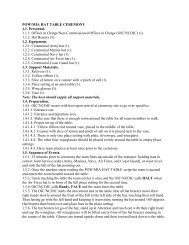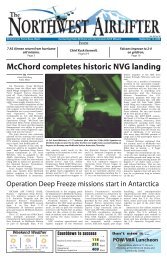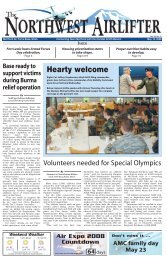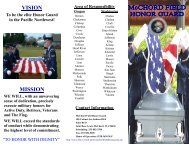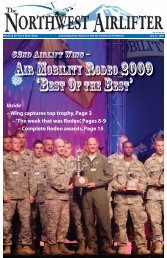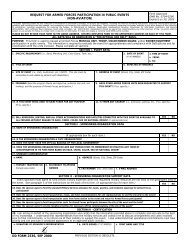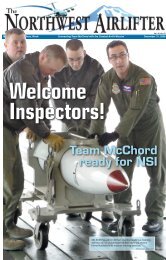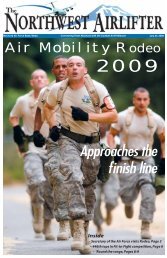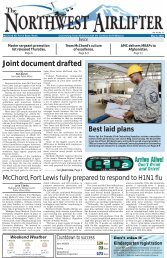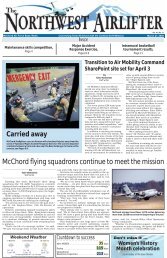May 2 - McChord AFB
May 2 - McChord AFB
May 2 - McChord AFB
Create successful ePaper yourself
Turn your PDF publications into a flip-book with our unique Google optimized e-Paper software.
By<br />
1st Lt. Lisa Spilinek<br />
332nd Air Expeditionary Wing<br />
Public Affairs<br />
FEATURE<br />
Spotlight story<br />
Airmen train to protect against chemical attack<br />
BALAD AIR BASE, Iraq (AFPN) — They looked<br />
liked they were extras in a low-budget, sci-fi<br />
movie walking in slick green chemical suits with<br />
what looked like scuba-diving air tanks strapped<br />
to their backs. A massive dust storm added to<br />
the ambiance of the scene by casting a strange<br />
orange hue to the already odd-looking clan walking<br />
about Balad Air Base, Iraq, recently.<br />
These Airmen weren’t looking for fish-men or<br />
killer bees with a thirst for blood, however; they<br />
were seeking the answers to a different type of<br />
mystery, much scarier than the kind that lurks<br />
on television after 3 a.m.<br />
Instead these Airmen found an unknown powdery<br />
substance in one of the buildings on Balad<br />
AB, and it was up to the emergency management<br />
experts to determine what it was and if it posed a<br />
danger to the building occupants.<br />
While the situation was staged, it could have<br />
been the real thing and emergency managers<br />
deployed to locations throughout the area of<br />
responsibility would have been ready to identify<br />
and mitigate the risks involved.<br />
The unknown substance exercise event was<br />
one of many that Airmen from Balad, Kirkuk<br />
Regional AB, Ali Base and Al Asad Airfield participated<br />
in during a week-long emergency management<br />
training session that concluded April 19.<br />
“We provide emergency management and<br />
[chemical, biological, radiological and nuclear]<br />
response capabilities to Balad AB. We support<br />
national strategy by countering asymmetric use<br />
of [weapons of mass destruction] against U.S.<br />
forces’ ability to project power,” said Master Sgt.<br />
Michael Messina, 332nd Civil Engineer Squadron<br />
emergency management flight superintendent,<br />
deployed from Tyndall Air Force Base, Fla.<br />
The training session marked the second time<br />
during the past four months that emergency<br />
management personnel from Operation Iraqi<br />
Freedom locations came together to practice their<br />
skills, Sergeant Messina said.<br />
The session at Balad was not only significant<br />
to the air base, but the rest of the bases and forward<br />
operating locations in Iraq and the area of<br />
responsibility as well, said Senior Master Sgt.<br />
Photo by Senior Airman Julianne Showalter<br />
Staff Sgt. Amber Albano and Senior Master Sgt. Thomas Stoudt prepare to enter a building containing an<br />
unknown powder substance during a recent training scenario at Balad Air Base. The scenario was one of many<br />
that Airmen from Balad AB, Kirkuk Regional AB, Ali Base and Al Asad Airfield participated in during a week-long<br />
emergency management training session which concluded April 19. Sergeant Albano is deployed to 506th<br />
Expeditionary Civil Engineer Squadron as an emergency manager at Kirkuk Regional AB. Sergeant Stoudt is<br />
deployed to Southwest Asia as the functional manager for the emergency management career field.<br />
Thomas Stoudt, who is the deployed to<br />
Southwest Asia as the functional manager for the<br />
emergency management career field.<br />
“This is an AOR exercise. We provide a capability<br />
to commanders to protect forces from any TIC<br />
or TIM [toxic industrial chemical or toxic industrial<br />
material] so that they can still do their mission,”<br />
said the sergeant deployed from Air<br />
National Guard Headquarters in Washington D.C.<br />
One benefit of the training session was that<br />
the participants had the opportunity to practice<br />
using their specialized gear, which includes various<br />
types of protective clothing and technological<br />
gadgetry that they use to identify and collect<br />
potentially dangerous substances.<br />
“The challenge is that at home station, we<br />
don’t always get to use the equipment. Here we<br />
have the continued opportunity to take stuff out<br />
to play with it,” said Senior Airman Kevin<br />
Phillips, who is deployed from Robins Air Force<br />
Base, Ga.<br />
While the emergency managers at Balad do<br />
some form of hands-on training at least weekly,<br />
bringing personnel together from across the AOR<br />
allowed those gathered to standardize the techniques<br />
that they employ so they are prepared to<br />
respond to any type of situation, Sergeant Stoudt<br />
said.<br />
“It’s an [explosive ordnance ground] war right<br />
now. If it turns into a CBRN war, we have to be<br />
ready,” Sergeant Stoudt said of fighting the war<br />
on terrorism.<br />
Knowing that emergency managers are trained<br />
and ready provides reassurance to commanders<br />
and subordinates alike.<br />
“We provide peace of mind for the base,”<br />
Airman Phillips said. “We are the teddy bear you<br />
can hold at night.”



